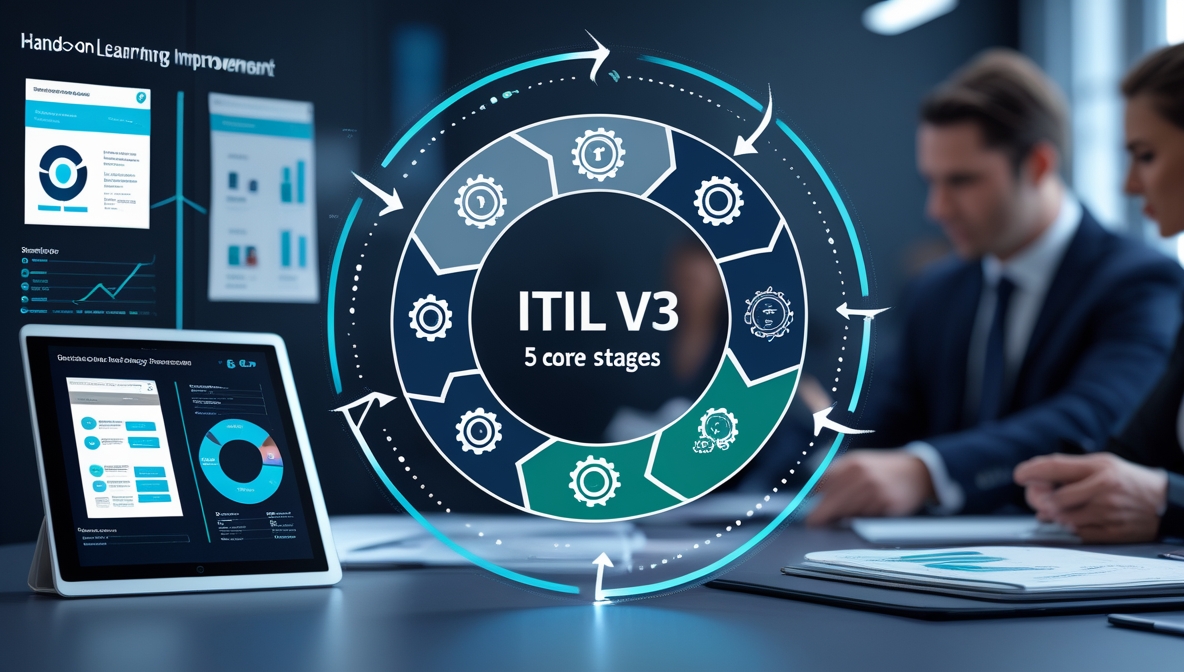This ITIL v3 framework introduction explores how IT service management can align with business goals through lifecycle-based design, delivery, and improvement.
The ITIL v3 framework remains one of the most widely adopted models for IT service management (ITSM) worldwide. Organizations of all sizes continue to use its lifecycle-based structure to deliver services that are efficient, reliable, and aligned with business needs. This practical introduction provides a foundational understanding of ITIL v3, covering key processes, roles, and the principles that drive service excellence. It is designed to help IT leaders, managers, and teams grasp the full spectrum of ITIL’s capabilities and how they apply in real-world service environments.
Modern IT environments are increasingly complex, supporting diverse services across multiple platforms, user groups, and compliance requirements. As businesses rely more heavily on digital services, IT must ensure not just uptime, but also measurable value, consistent performance, and user satisfaction. This requires a disciplined approach to designing, transitioning, operating, and continually improving IT services. The ITIL v3 framework offers a structured and proven methodology to meet these expectations, with globally recognized best practices embedded across its five lifecycle stages.
Despite the increasing strategic importance of IT, many organizations struggle with inconsistent service delivery, poor user experience, and reactive firefighting. Teams may lack clarity on roles, priorities, or ownership. Services are often delivered in silos, disconnected from business objectives, resulting in redundant processes, wasted capacity, and frequent disruptions. According to Gartner, over 80% of service interruptions are caused by operator error or poor change control—issues directly addressed by ITIL.
These challenges not only affect internal efficiency but also erode trust in IT across the business. CIOs and IT leaders often find themselves answering difficult questions about service outages, lack of responsiveness, and the perceived gap between technology investment and business value. When teams operate without a common language, defined processes, or measurement systems, the gap between IT operations and strategic business priorities only widens—leading to increased costs, risk exposure, and missed opportunities for innovation.
This introduction to the ITIL v3 framework provides a clear and actionable pathway out of that chaos. It walks through the entire service lifecycle—from strategy to continual improvement—explaining how each stage contributes to reliable, business-aligned service delivery. Key topics include service level management, change and release processes, configuration management, problem resolution, and knowledge sharing. It also introduces critical roles such as the Change Manager, Service Owner, and Configuration Analyst, and explains how functions like the Service Desk support seamless operations. Supporting tools such as the Configuration Management System (CMS) and Service Knowledge Management System (SKMS) are presented as enablers of consistent, informed decision-making.
By grounding IT services in structured, repeatable processes and aligning those processes with business priorities, the ITIL v3 framework helps IT organizations become more proactive, strategic, and valuable to the enterprise. Whether you are building a formal ITSM practice or simply seeking to bring greater order and visibility to service operations, this guide provides the essential concepts and vocabulary to start that journey.
Main Contents
- Overview of the ITIL v3 Service Lifecycle: Strategy, Design, Transition, Operation, and Continual Improvement
- Explanation of Core ITSM Concepts: Services, Service Levels, Incidents, Problems, and Configuration Management
- Introduction to Key Roles and Responsibilities: Change Manager, Service Owner, Configuration Analyst, and more
- Processes Supporting Service Delivery: Change Management, Release Management, Incident and Problem Management
- Supporting Systems and Tools: Configuration Management System (CMS) and Service Knowledge Management System (SKMS)
Key Takeaways
- ITIL v3 provides a structured framework for aligning IT services with business goals
- Service management success depends on clear roles, defined processes, and measurable outcomes
- Poor change control is a leading cause of service disruptions, which ITIL directly addresses
- The ITIL lifecycle enables organizations to plan, deliver, and continuously improve IT services
- Adopting ITIL fosters operational efficiency, reduces risk, and enhances customer satisfaction
The ITIL v3 framework is more than a theoretical model—it's a practical toolset CIOs and IT leaders can use to address many of the operational, strategic, and organizational challenges they face. This document offers a foundational understanding of ITIL v3 that enables decision-makers to implement structured, value-driven service management in real-world IT environments.
- Establish IT-business alignment: Use the ITIL v3 framework to design services that support business goals and strategic outcomes, ensuring IT investments generate measurable value.
- Improve service reliability and consistency: Apply lifecycle principles and standard operating procedures to reduce incidents, improve uptime, and enhance user experience.
- Strengthen change and risk management: Leverage change and release management processes to reduce disruptions, improve governance, and minimize risk during transitions.
- Build a performance-focused culture: Adopt key performance indicators (KPIs) and service level agreements (SLAs) to monitor, measure, and continuously improve IT performance.
- Enhance cross-functional collaboration: Define clear roles and processes that cut across silos, improve communication, and promote accountability across teams and vendors.
By applying the ITIL v3 framework as described in this document, CIOs can create a disciplined, transparent, and adaptable IT organization—one that delivers consistent results, scales with business needs, and earns trust at every level.


